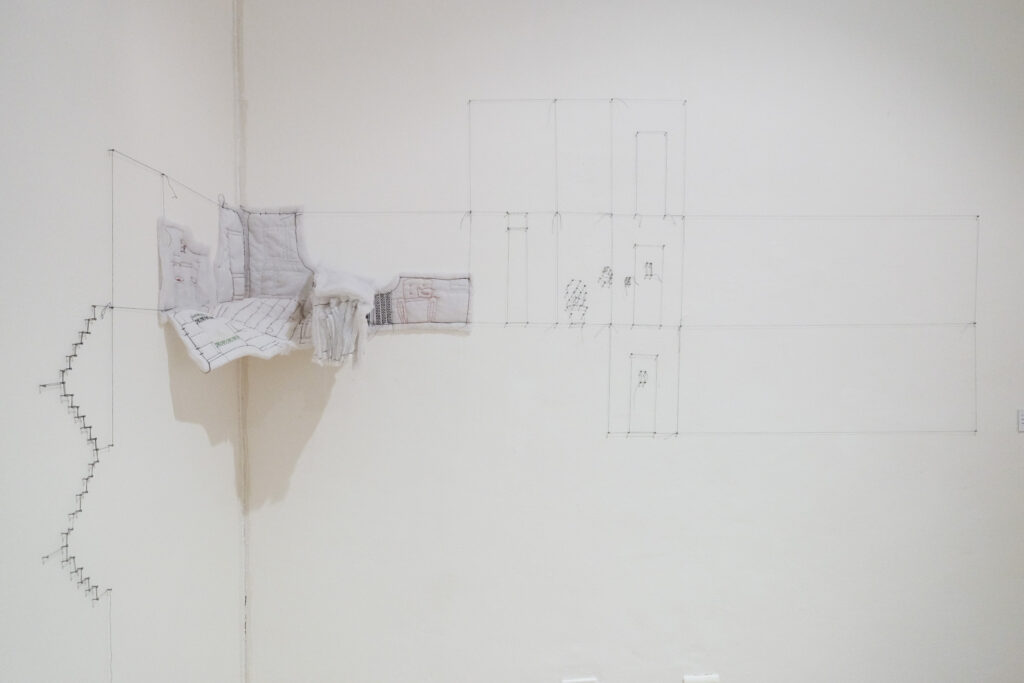
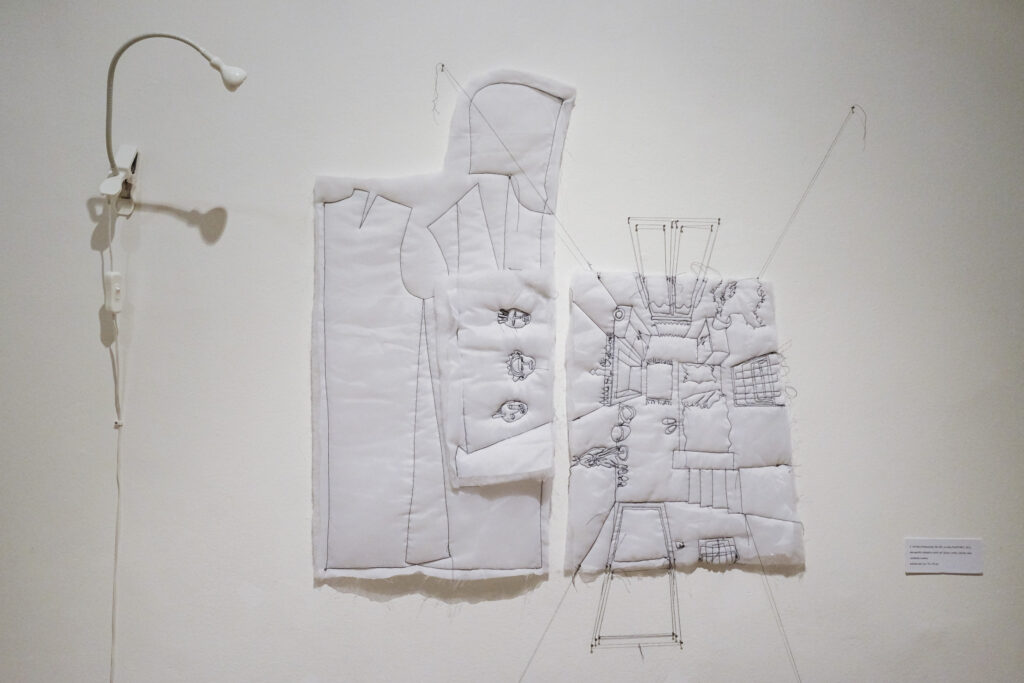
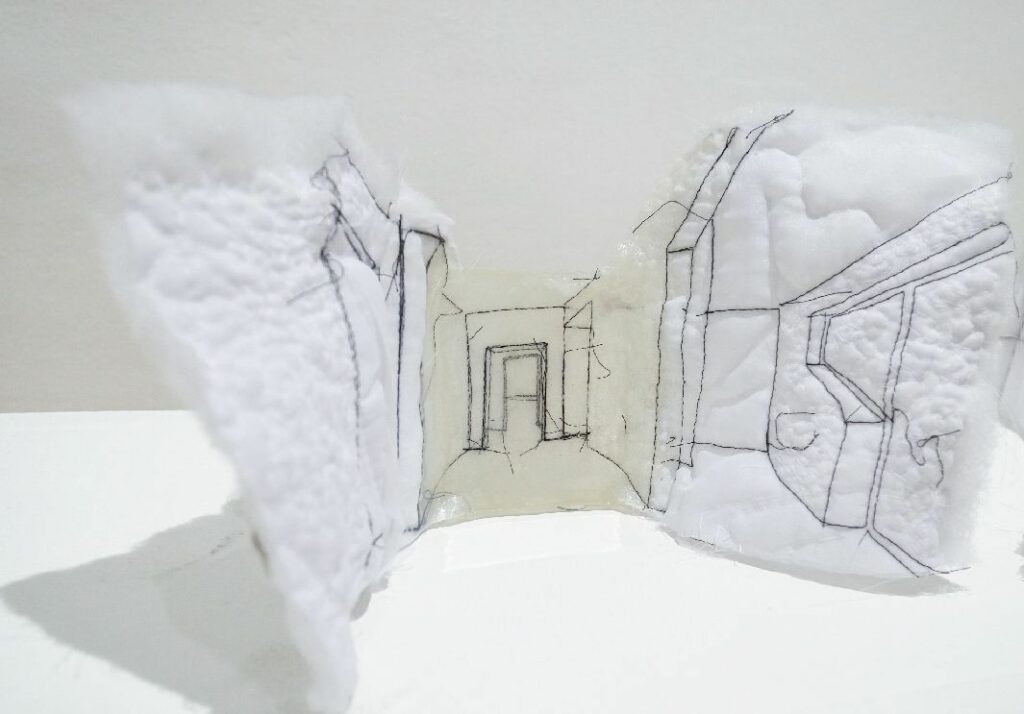
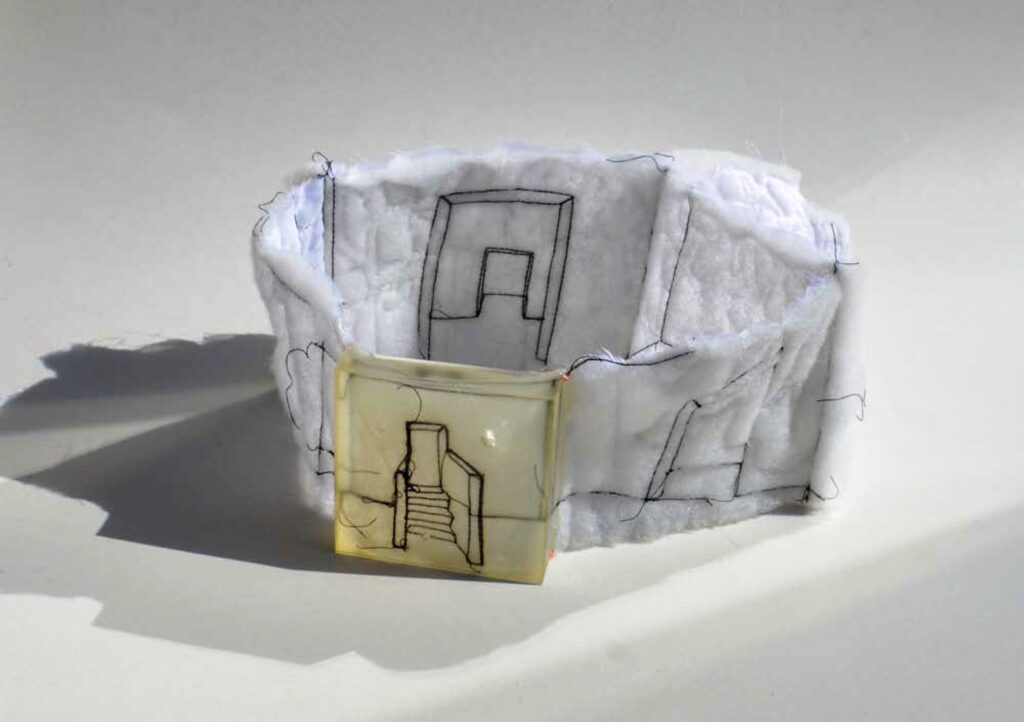
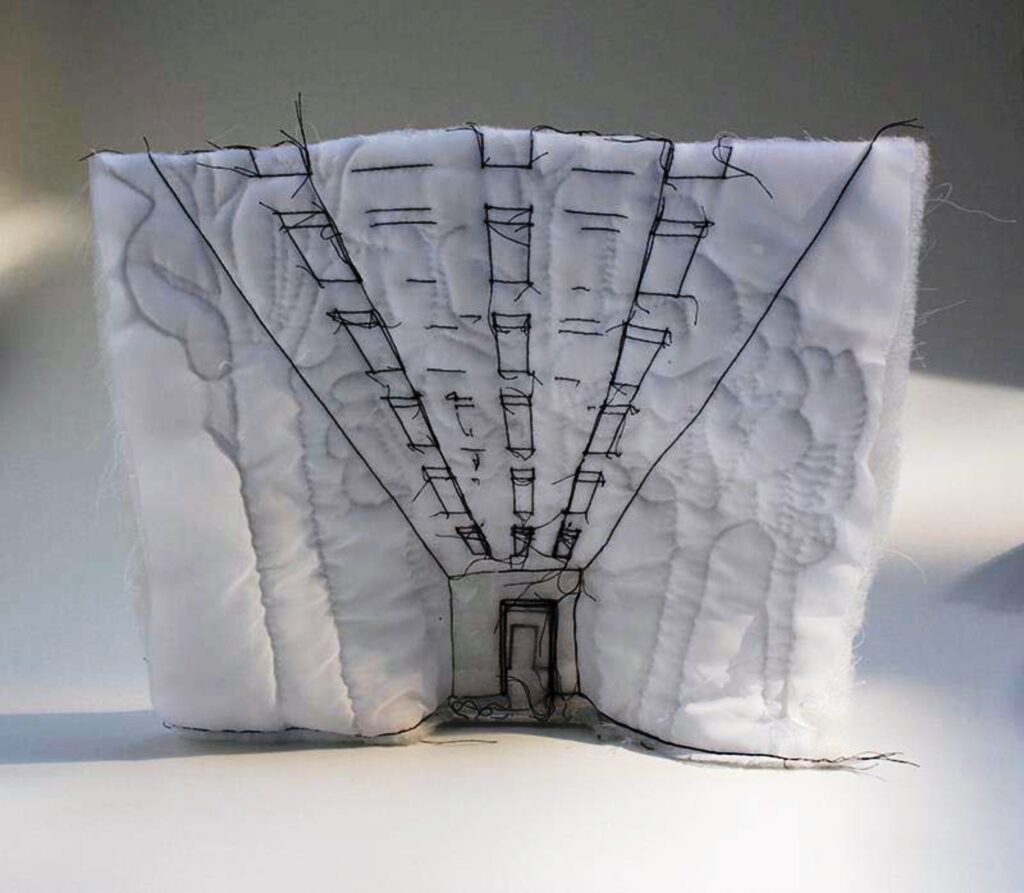
Mira Podmanická represents a generation of young Slovak sculptors whose work connects fine art with techniques that belong mostly to the territory of applied arts. Podmanická rarely uses standard sculptural materials (stone, metal, wood) a traditional techniques (carving, welding, cutting). She mostly focuses on soft materials (textile, threads) and soft approaches (stitching, needlework) that tend to be described as “feminine”. However, the artist distances herself from this labelling: “I am really trying to make people accept these ʻfeminineʼ techniques and approaches and perceive them as equal. […] Regarding the materials I use, they inspire me. But it’s just material. It’s the thought that counts. Material has to match the idea and support it. And so does the technique. […] I have worked with various materials, but I have been focusing on textile for a while now. And it just keeps giving. But when I’m using it, I don’t see it as something feminine.” 1
Space plays an important role in Mira Podmanická’s work besides material experiments. On one hand, it is the basic factor in sculpture art generally (besides space, the other important factors are material and time) and it keeps exploring its possibilities. On the other hand, the artist is interested in working with the exhibition space and the way the viewer perceives it, creating site-specific installations, decomposing architecture into objects and spaces into surfaces.
Besides being a freelance artist, Podmanická also spends her time on design and jewelry (she is known and praised for her plastic jewelry that resembles chocolate), art-design collaborations (mostly with Markéta Nováková on the Bio-Vases collection) or holding exhibitions.
The group of artworks by Podmanická in the Nitra Gallery’s collection fund contains objects from various cycles where the artist explores similar themes and strategies: Spaces [Priestory] (2011), PrieSTORY (2012) and Mini-Spaces(2015). A part of them was presented in 2012 at a site-specific exhibition titled Micro-Installations at the Nitra Gallery’s Bunker, curated by Mira Sikorová-Putišová. The main themes of these textile objects are space and architecture that overlap with sewing patterns. Just as clothes cover our body, architecture covers us as well. Walls serve as a layer of protection from outer elements (cold or hot weather…). Objects create “inter-spaces” that turn a two-dimensional sewing pattern into a three-dimensional piece of architecture. What’s important is the way the pieces are installed and how they work with the gallery’s exhibition space. Unlike a classic statue that is constant and solid, these are fragile textile objects hanging on the walls and sitting on stands. They create ephemeral, variable, soft and bendable architectures. Black embroidery on white textile background is supplemented with thread drawings that extend out of the objects – out of the “interior” – and seamlessly join the “exterior” (gallery wall). The artist uses a creative way to attach threads to nails while visually referring to technical drawings and floor plans.
Regarding Podmanická’s way of installing her artwork in space, the art theorist Mira Sikorová-Putišová wrote: “The actual place of installation/presentation is occupied and described at the same time by subtle soft textile installations – representations of “micro-spaces” that are completely infused in it. This approach highlights the specifics of both spaces at the same time – the exhibition space and the constructed micro-installation. Light plays an undeniable role in this configuration as it is a part of the complex artwork that supports the creation of its mysterious atmosphere. The actual micro-installations, either hand-sewn or machine-sewn compositions, are the key to uncovering different kinds and forms of space. Even though these are not tangible and cannot be physically measured, they are more like allusions (hints) of other spaces, but most specifically to the events they refer to. They serve as memory models of spaces that can be perceived as records of the previously evaporated events that took place in them.” 2
Objects titled Flat No. 1 and Flat BE represent a view inside apartments that are outlined using simple lines and that the artist creates by combining tailoring techniques with architectonical drawings. Three other pieces from the Mini-Spaces series are, in comparison with some of Podmanická’s older works, freestanding objects that outline views of corridors and doors that lead to other real or imaginary spaces. These works are “inhabited” by various only assumed stories that the artist intentionally does not clarify, which leaves them open to the viewers’ imagination. It has a similar effect as watching a neighboring apartment building and staring into someone’s kitchen while trying to imagine the story of the apartment and the family that lives in it.
Mira Podmanická was born in 1981 in Ružomberok, Slovakia. From 1995 to 1999 she studied at the School of Applied Art in Ružomberok, majoring in clothes design. From 1999 to 2006 she studied at the Department of Sculpture, Object, Installation at the Academy of Fine Arts and Design in Bratislava. At first she studied under prof. Jozef Jankovič and later at the Studio „Flat Sculpture as well“ S.O.S (Sculpture objective – subjective) under doc. Ján Hoffstädter, akad. soch. In 2011, she finished her doctoral studies at this studio and she has been working there since as a lecturer and foreign students’ coordinator. She herself has participated in several student programs at Académie Royale des Beaux-Arts de Bruxelles in Belgium at the Studio of Sculpture led by Jean-François Diord and at the Faculty of Fine Arts at the Brno University of Technology at the Studio of Video led by prof. Peter Rónai. In 2007 she was a finalist of the Essl Art Award CEE in Bratislava and in 2013 she received a special acknowledgment at the Prix Louis Schmidt in Brussels and Grand Prix at the Bienále Forma in Bratislava. She lives and works in Bratislava.
— Omar Mirza, May 2017
Literature
1 ČÚZYOVÁ L., Silvia. Transfiguration based on art/design/art (interview with Mira Podmanická). In: PROFIL magazine for contemporary art, Vol. 3/2015, Year. XXII, p. 95, ISSN 1335-9770.
2 Citation of the curator’s text from the exhibition Micro-Installations, Nitria Gallery – Bunker, 28 March – 20 May 2012, curator: Mira Sikorová-Putišová.
Inventory No.: F 139
Artist: Mira Podmanická
Title: Flat no. 1 (from the series prieSTORY)
Year of origin: 2011
Technique: combined
Material: combined
Dimensions: variable
Signature: none
Inventory No.: F 140
Artist: Mira Podmanická
Title: Flat BE (from the series prieSTORY)
Year of origin: 2012
Technique: combined
Material: combined
Dimensions: variable
Signature: none
Inventory No.: F 141
Artist: Mira Podmanická
Title: Mini-Space 8
Year of origin: 2015
Technique: combined
Material: combined
Dimensions: 33 × 26 × 7 cm
Signature: none
Inventory No.: F 142
Artist: Mira Podmanická
Title: Mini-Space 10
Year of origin: 2015
Technique: combined
Material: combined
Dimensions: 35 × 26 × 13 cm
Signature: none
Inventory No.: F 143
Artist: Mira Podmanická
Title: Mini-Space 11
Year of origin: 2015
Technique: combined
Material: combined
Dimensions: 38 × 31 × 4 cm
Signature: none